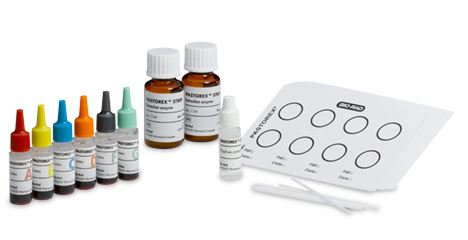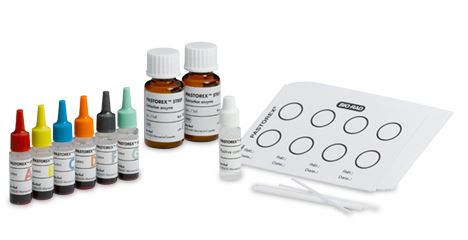TEST, STREPTOCOCCUS A, B, C, D, F, G (Pastorex), 1 test
Valid Article
Streptococcus A, B, C, D, F, G LATEX AGGLUTINATION(Pastorex)
CAUTION
This test is worded and codified by unit to make the order easier, but it is always packaged in kit of 60.
Definition
PASTOREX STREP is a rapid agglutination test for grouping streptococci according to Lancefield classification. The test involves use of latex suspensions specific for groups A, B, C, D, F, and G.
This kit is only to be used on cultured bacteria, not directly on specimen.
Specifications
Components
Each kit contains:
- Six vials of 1 ml of latex suspension, specific for group A, B, C, D, F, and G streptococci, respectively. The latex particles are coated with group-specific rabbit immunoglobulins.
- Two vials of freeze-dried extraction enzyme. The content of the vial should be reconstituted with 10 ml distilled water.
- One vial of 1.5 ml polyvalent positive control antigen, made of an extracts mixture of Lancefield of group A, B, C, D, F, and G streptococci.
- 3 x 125 disposable rods
- 4 x 15 disposable agglutination cards (8 circles).
Technical specifications
- Specimen: cultured bacteria (not directly on clinical specimen!)
Packaging & Labelling
Kit for 60 tests:
- 6 x 1 ml vials
- 1 x 1.5 ml vial
- 2 bottles of liophilised extraction enzyme
- 60 agglutination cards
- 375 mixing sticks
To be Ordered Separately
- Micropipettes for 40 µl and 300 µl
- Pipettes for 10 ml
- Loop for the collection of bacterial colonies
- Sterile distilled water
- Sterile physiological water
- Hemolysis tubes or micro-tubes (1 per strain to be tested)
- Timer
- Disinfectant bath
- Dry incubator
Instructions for use
- Let the reagents get to room temperature before starting the test.
- Shake the bottles of latex before use.
- Hold the bottle with latex in vertical position when placing the drop.
- Use a new rod for each reaction.
- Do not touch the reaction surface of the agglutination card.
- Ensure that the caps of the dropper bottles are firmly tightened to avoid contamination or drying of the reagents.
- Use distilled water for reconstitution of enzyme extraction
Please consult the “Bacteriology laboratory procedures and resources” available online via the Laboratory working Group sharepoint page: Laboratory Procedures and Resources https://msfintl.sharepoint.com/sites/msfintlcommunities/LabWG/SitePages/Bacteriology-Laboratory-Resources.aspx
For offline access, contact your laboratory advisor
Precautions for Use
All biological samples must be considered as potentially infectious and handled with the usual precautions (compulsory wearing of gloves, hand washing, etc.).
Avoid any contact with the eyes, skin and mucous membranes (presence of sodium azide).
Storage
- Store between 2°C and 8°C
- Do not freeze
- Not to be used beyond expiry date
- After reconstitution, the extraction enzyme is stable up to 4 months at 2 to 8°C
- Shelf life: 12 months
- Guaranteed minimum remaining shelf life at delivery: 1/3 of the total shelf life
Waste management
After use, sterilise the cultures and all contaminated material.
Presence of substances with hazardous characteristics. Please contact your watsan referent for advice on proper disposal.
Detailed hazard and precautionary information can be found in the safety data sheet (SDS).
Classification EC Regulation N° 1272/2008
Extraction enzyme:
- Causes skin irritation, Category 2 H315
- Causes serious eye Irrit. Category 2 H319
- May cause respiratory irritation. Category 3 H335
Polyvalent positive control antigen + Strep A-G latex:
- Skin Sens. Category 1 H317
- Aquatic Chronic Category 3 H412
Signal Word
Warning
(Extraction enzyme)
| H315 | Causes skin irritation |
| H319 | Causes serious eye irritation |
| H335 | May cause respiratory irritation |
| P405 | Store locked up. |
| P261 | Avoid breathing dust/fume/gas/mist/vapours/spray. |
| P321 | Specific treatment (see ... on this label) |
| P302 + P352 | IF ON SKIN: wash with plenty of soap and water |
| P305 + P351 + P338 | IF IN EYES: rinse cautiously with water for several minutes. If the victim wears contact lenses, remove them if possible. Keep rinsing |
| P501 | Dispose of contents/container to location in accordance with local and regional/ national/ international regulations |
| P362 + P364 | Take off contaminated clothing and wash it before reuse. |
Signal Word
Warning
(polyvalent positive control antigen + Latex Strep A-C-F-G)
| H317 | May cause an allergic skin reaction |
| H412 | Harmful to aquatic life with long lasting effects |
| P273 | Avoid release to the environment |
| P280 | Wear protective gloves/protective clothing/eye protection/face protection |
| P302 + P352 | IF ON SKIN: wash with plenty of soap and water |
| P333 + P313 | If skin irritation or rash occurs: Get medical advice/attention. |
| P501 | Dispose of contents/container to location in accordance with local and regional/ national/ international regulations |
Signal Word
Warning
(Latex Strep B-D)
| H317 | May cause an allergic skin reaction |
| H412 | Harmful to aquatic life with long lasting effects |
| P273 | Avoid release to the environment |
| P280 | Wear protective gloves/protective clothing/eye protection/face protection |
| P321 | Specific treatment (see ... on this label) |
| P302 + P352 | IF ON SKIN: wash with plenty of soap and water |
| P333 + P313 | If skin irritation or rash occurs: Get medical advice/attention. |
| P501 | Dispose of contents/container to location in accordance with local and regional/ national/ international regulations |
MSF requirements
Reserved to bacteriology programmes





![[ELABTUBE12-] TUBE, Ø 12 mm, plastic, sterile, 5 ml + PLUG](/web/image/product.template/571504/image_256/%5BELABTUBE12-%5D%20TUBE%2C%20%C3%98%2012%20mm%2C%20plastic%2C%20sterile%2C%205%20ml%20%2B%20PLUG?unique=5d2557f)